Lecture # 2. Theory of government regulation




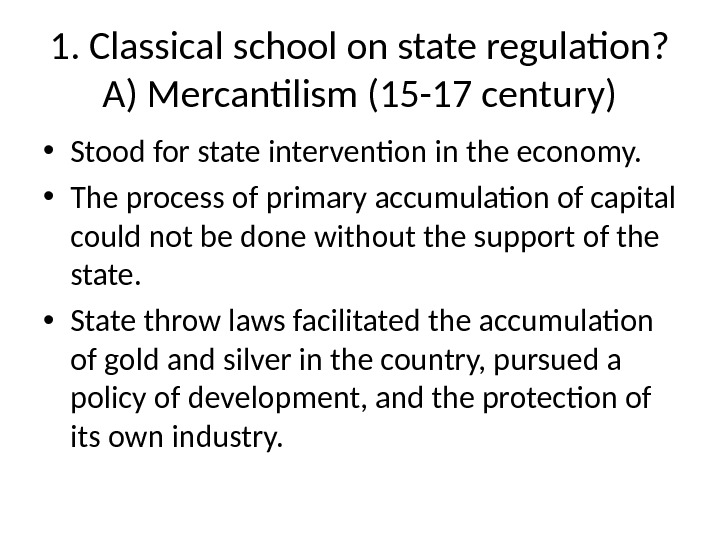



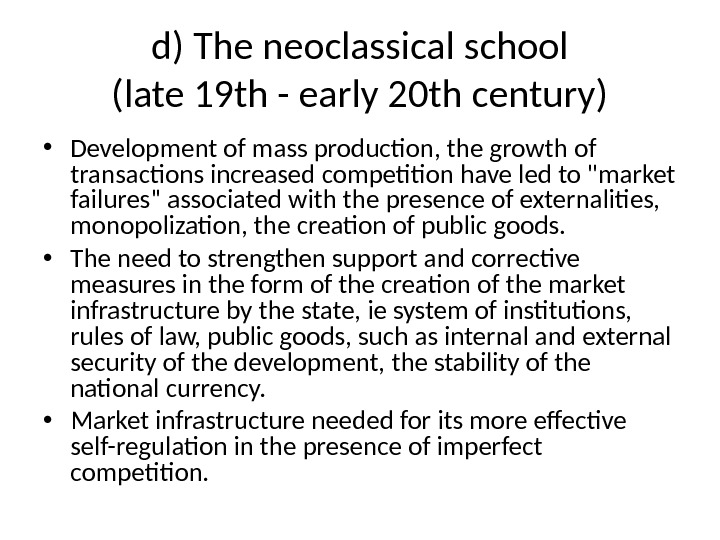


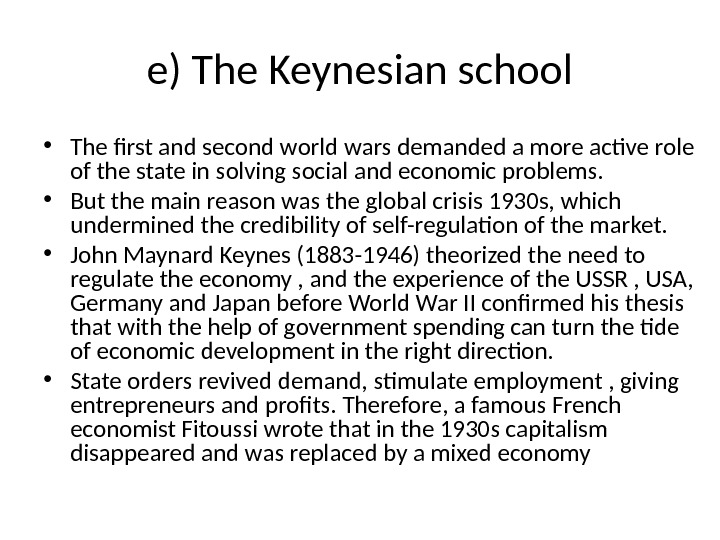
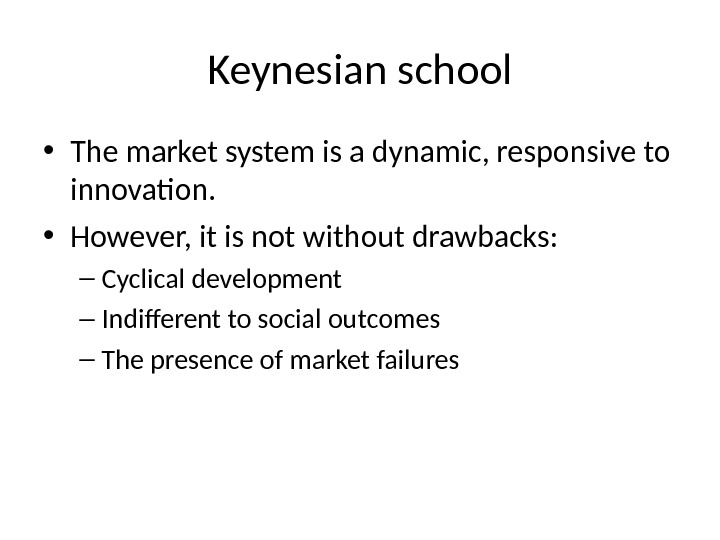
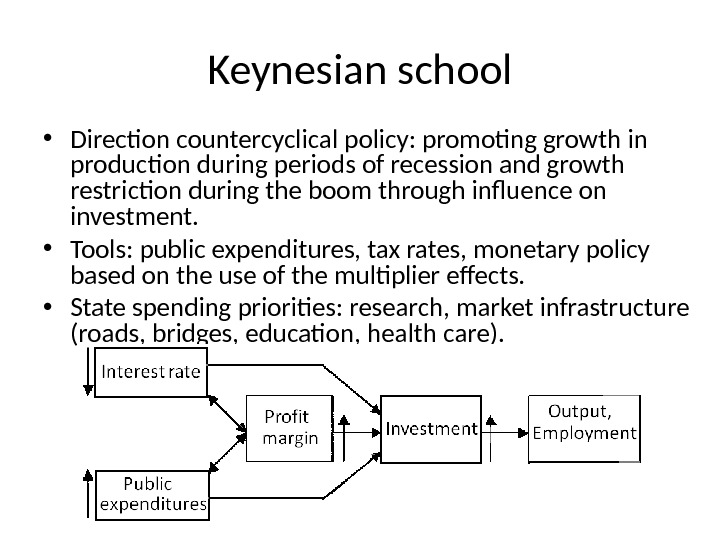
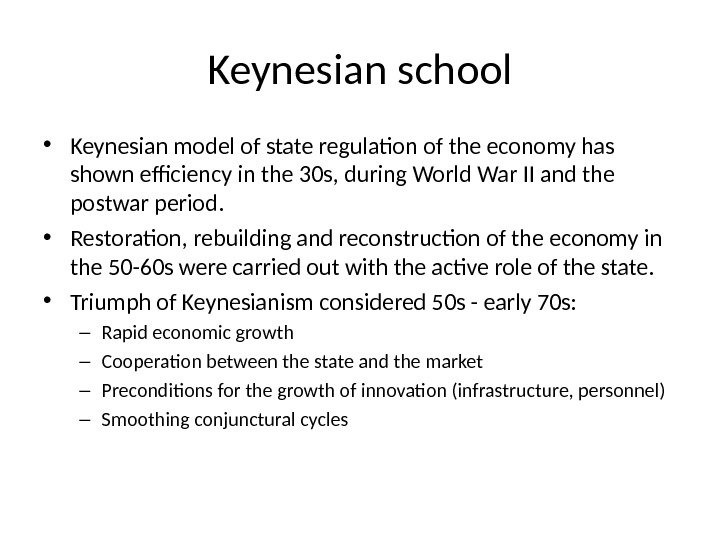
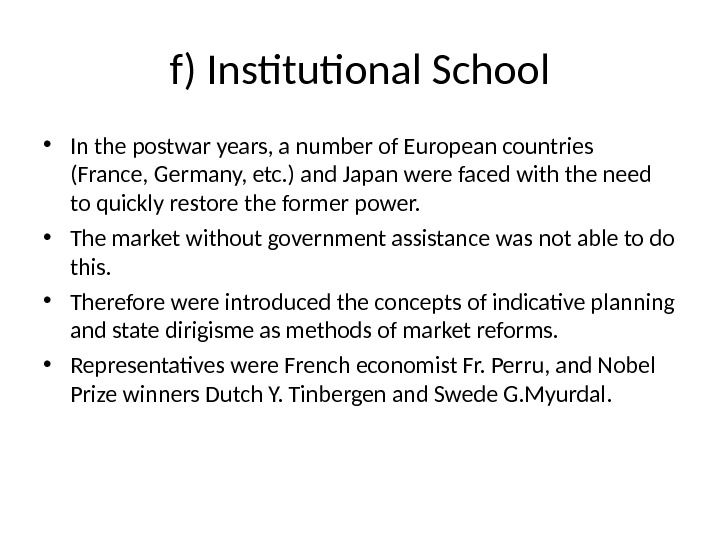
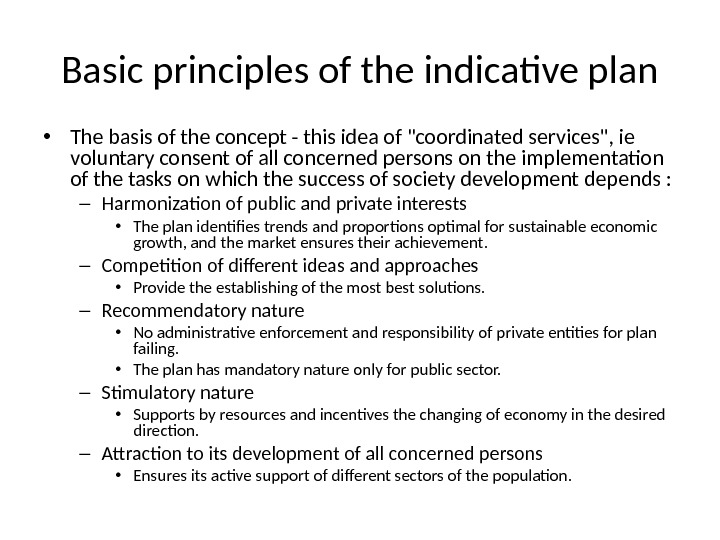
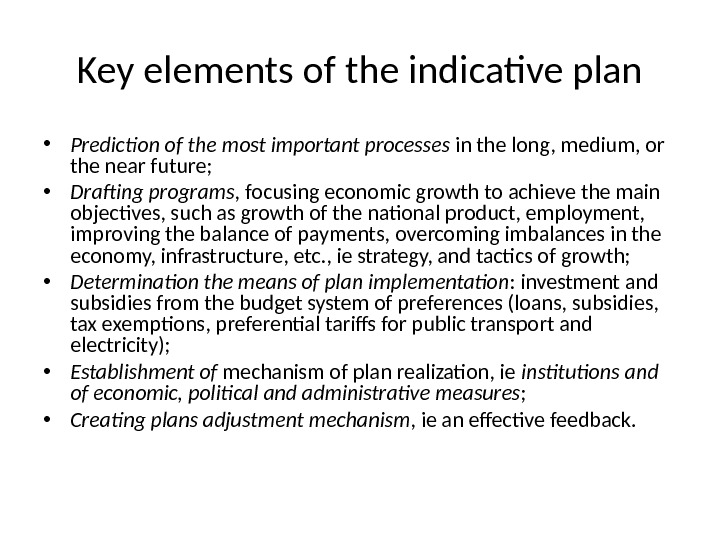
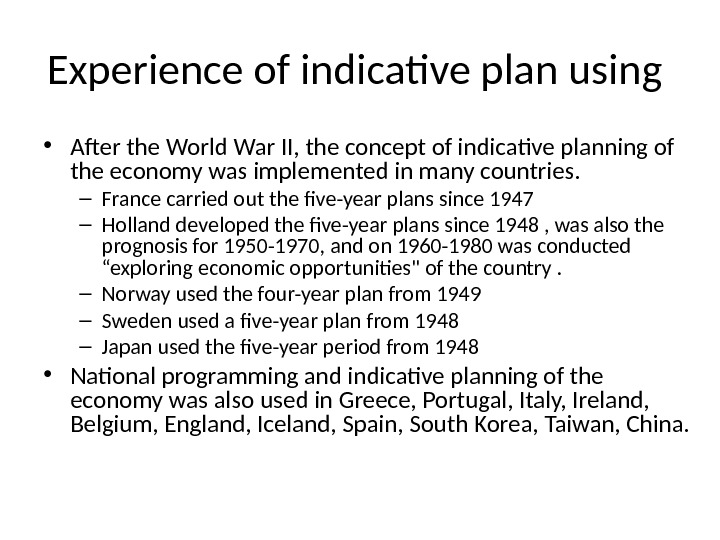


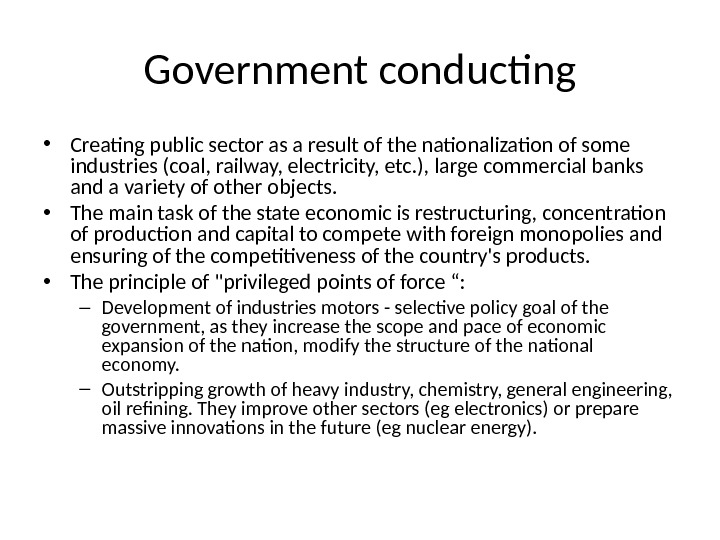
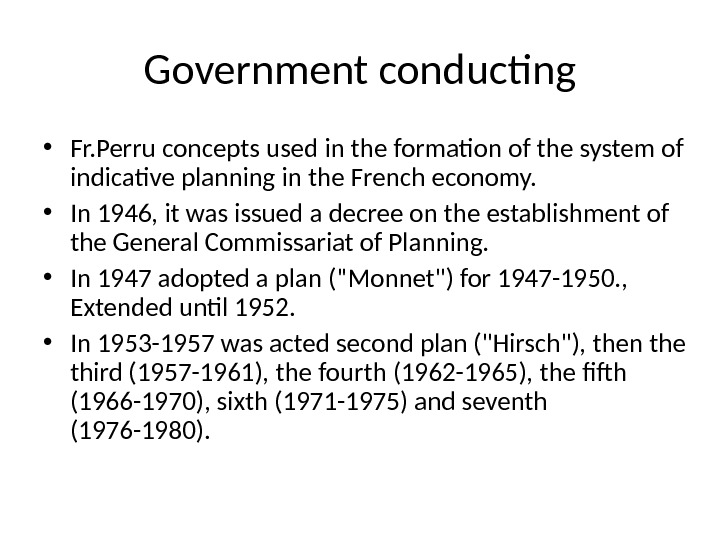
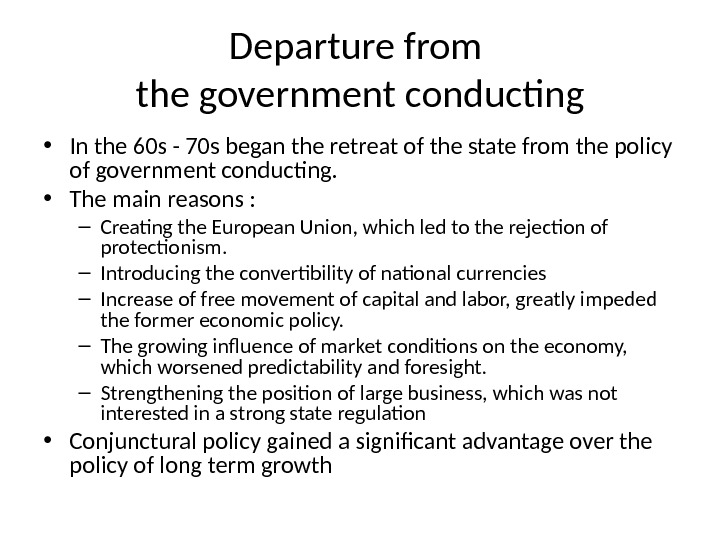
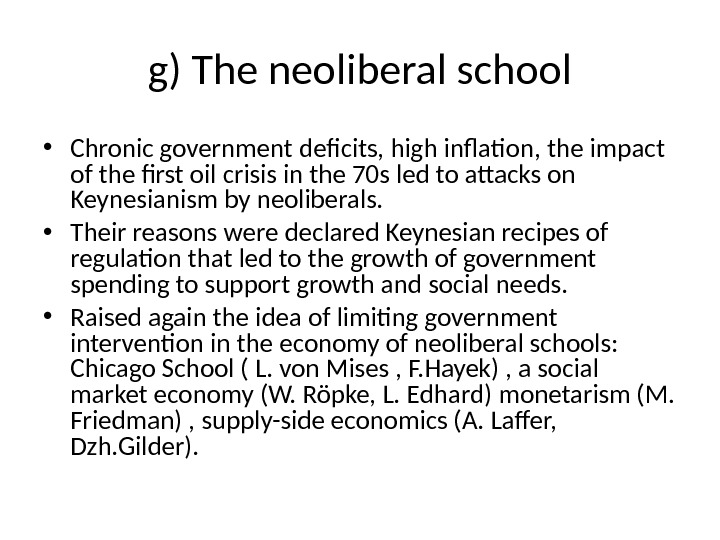
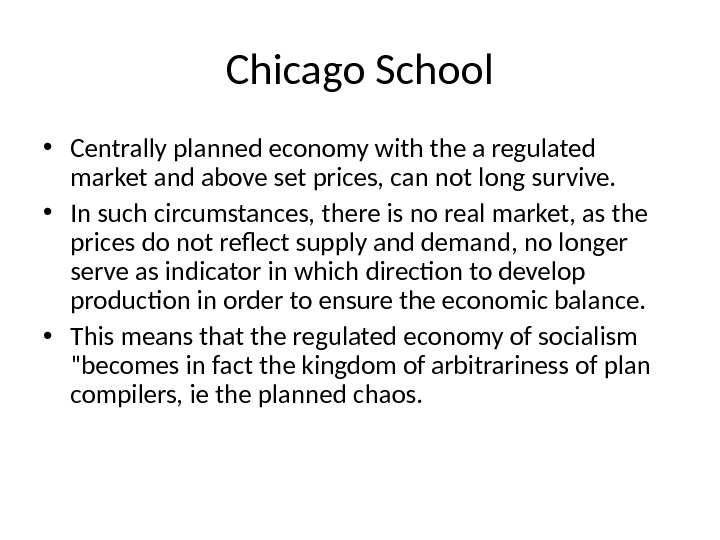

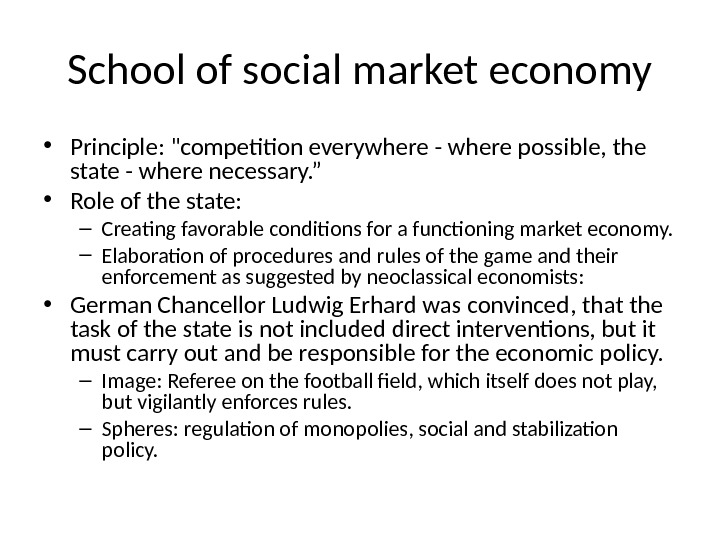
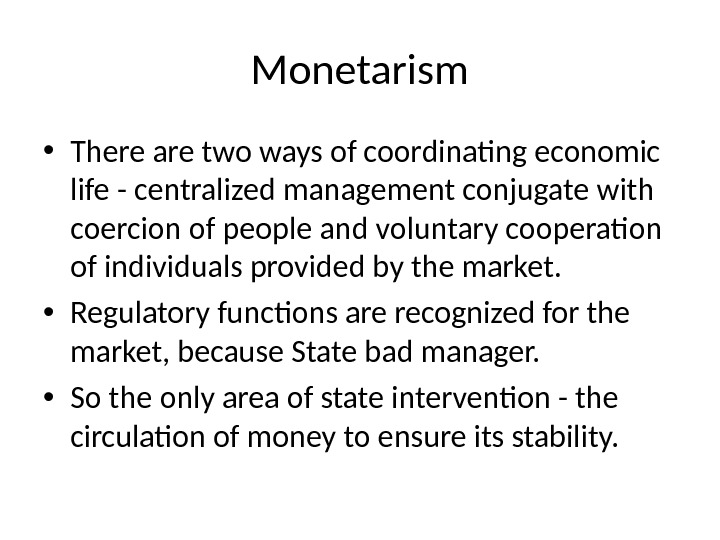





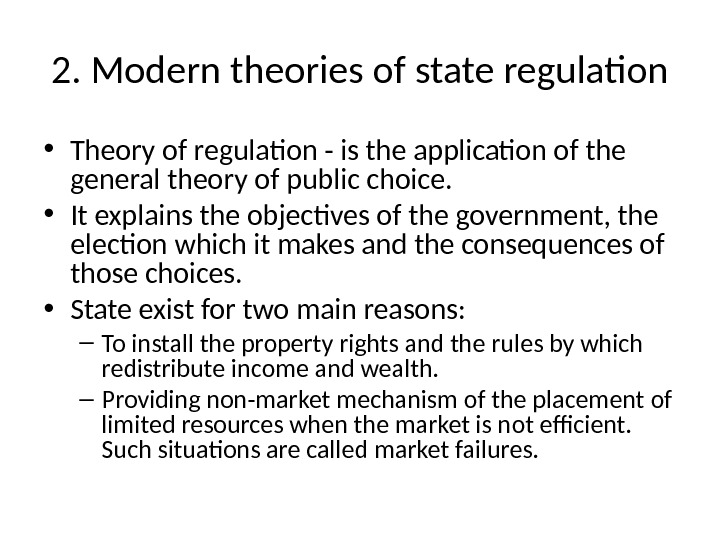
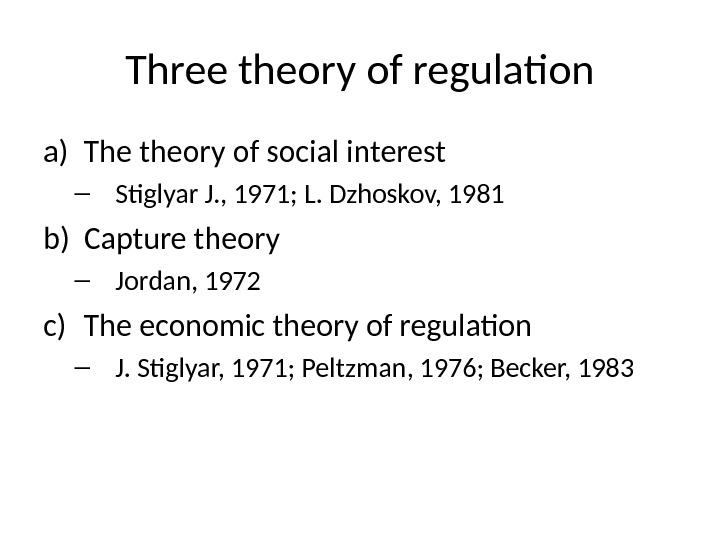

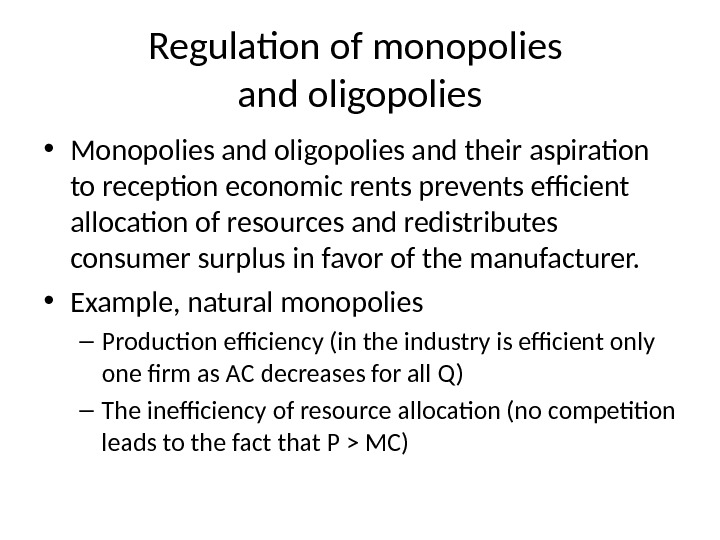


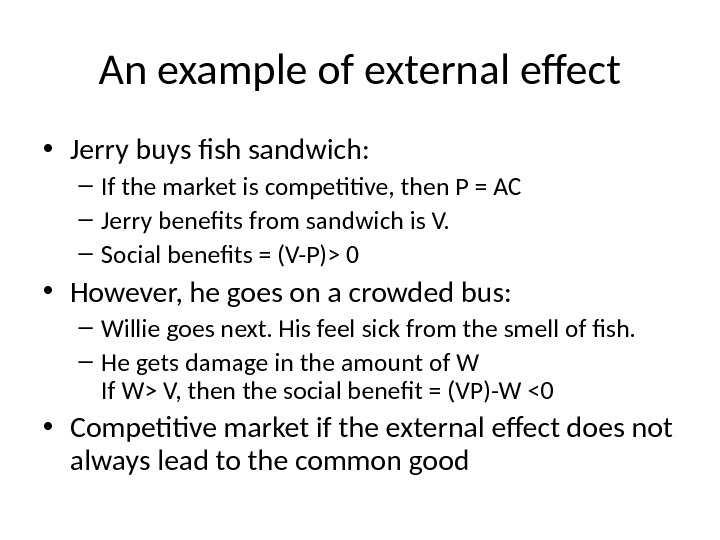
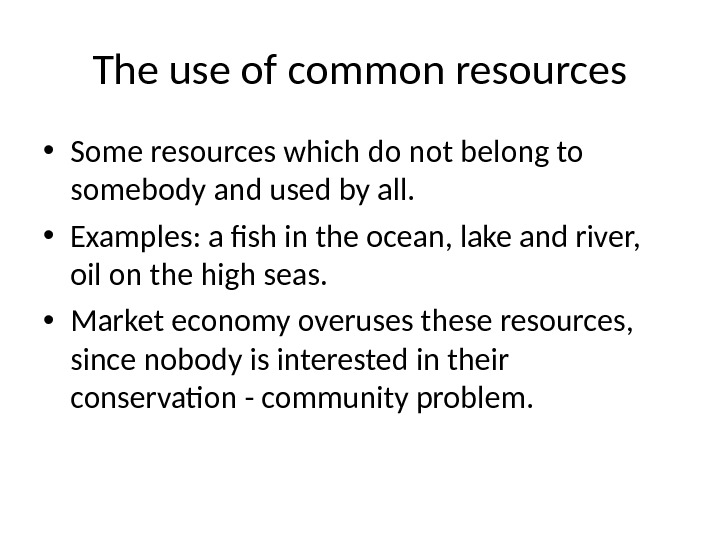


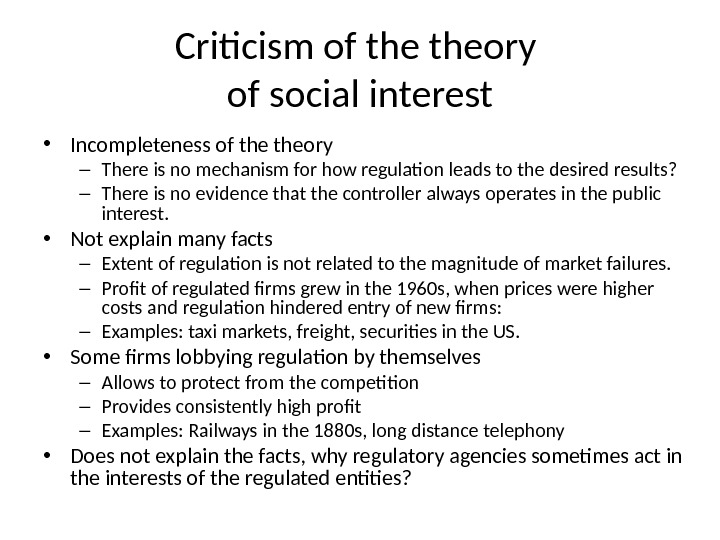

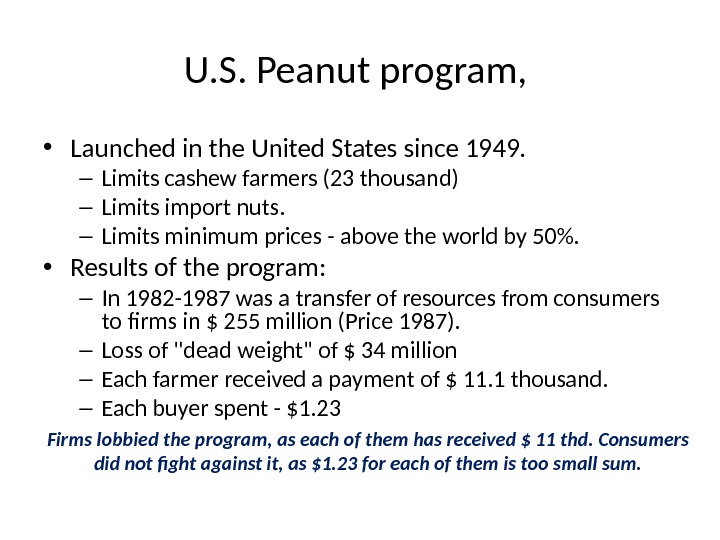


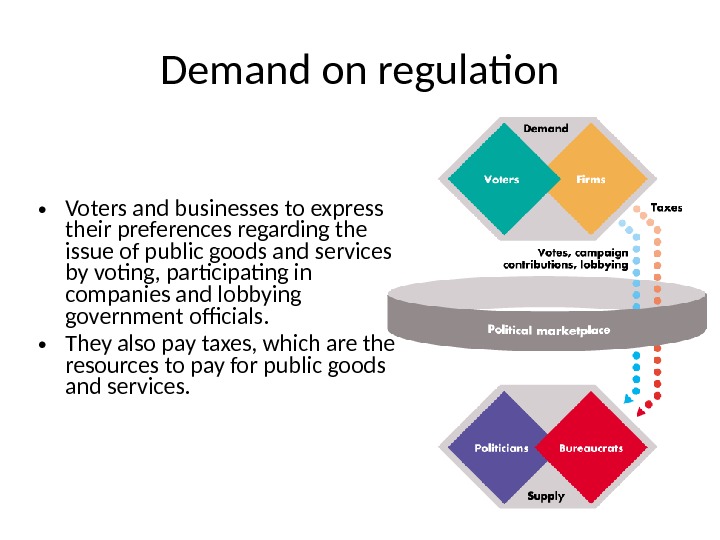
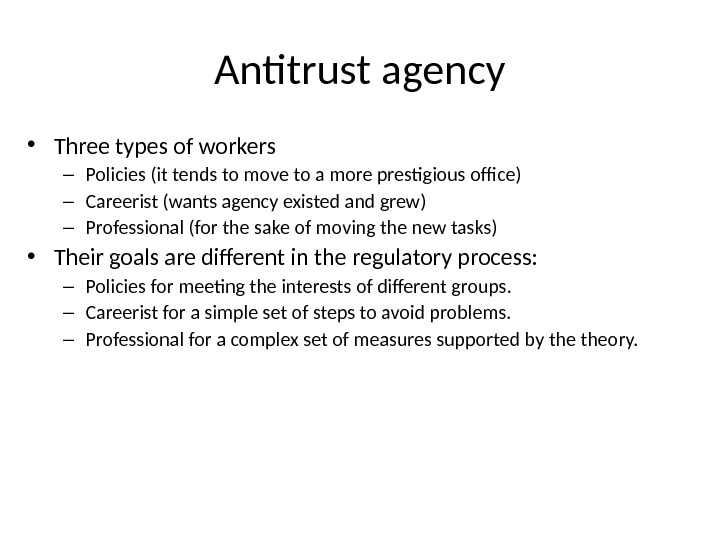
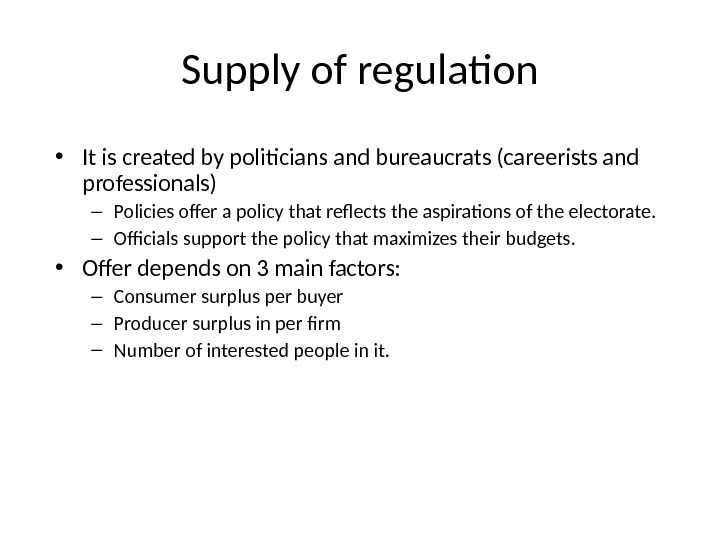
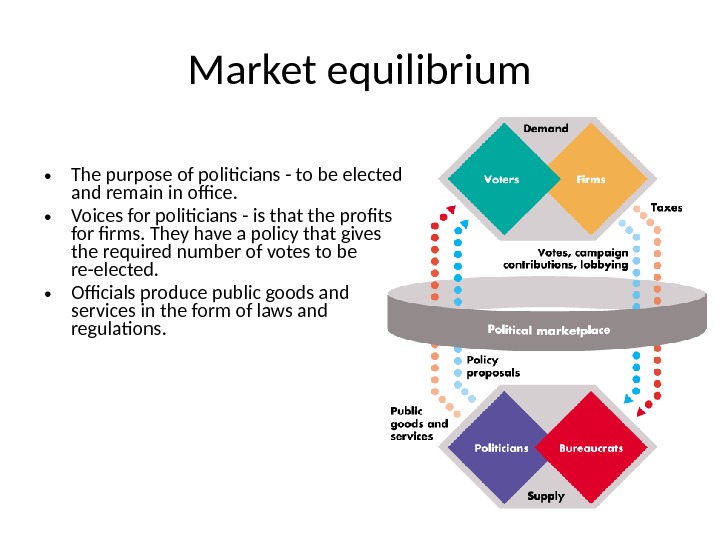

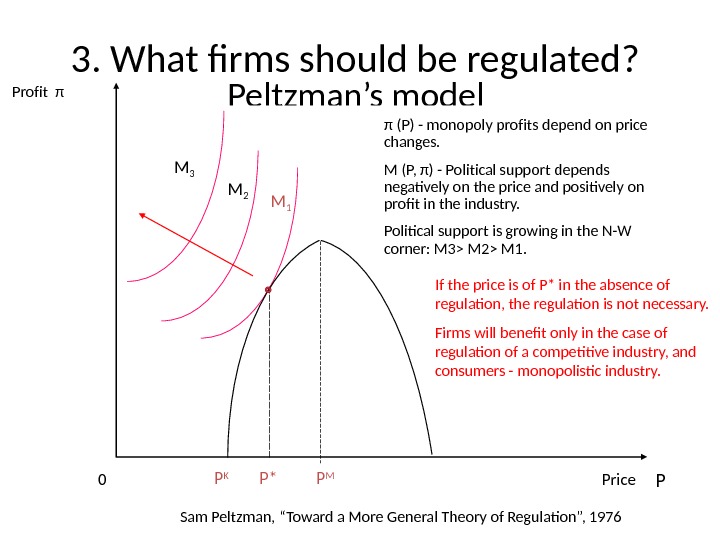
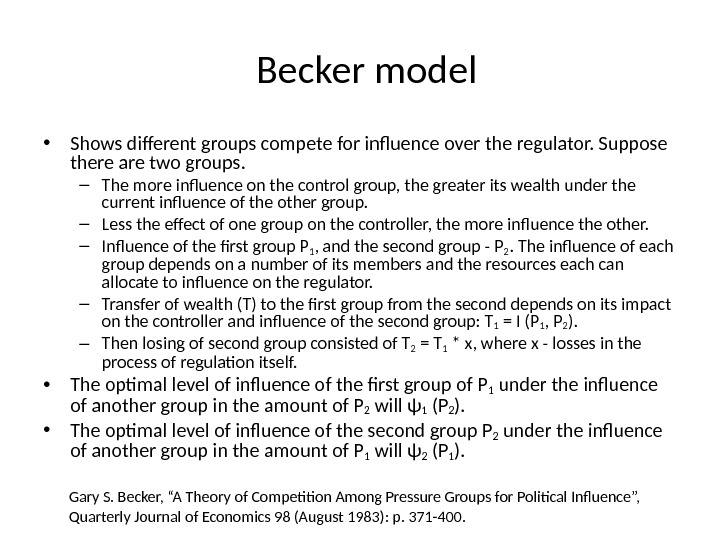
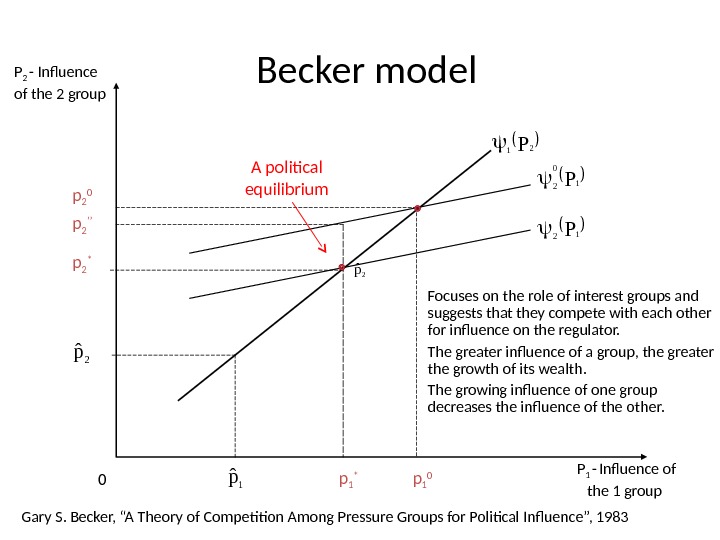
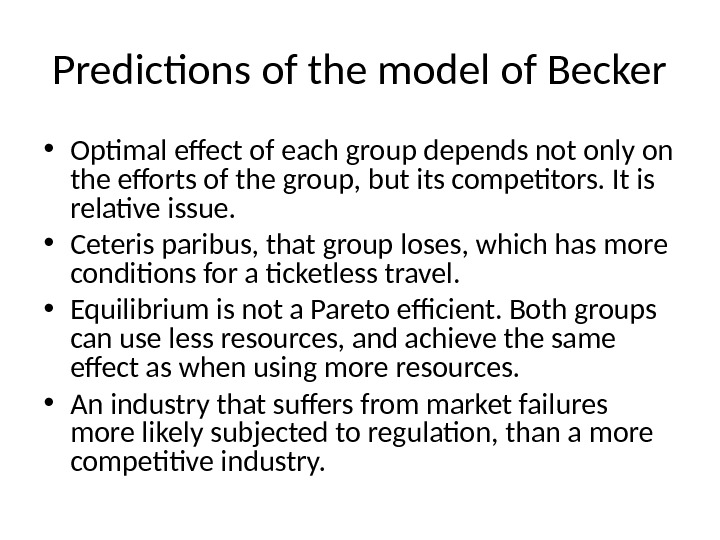

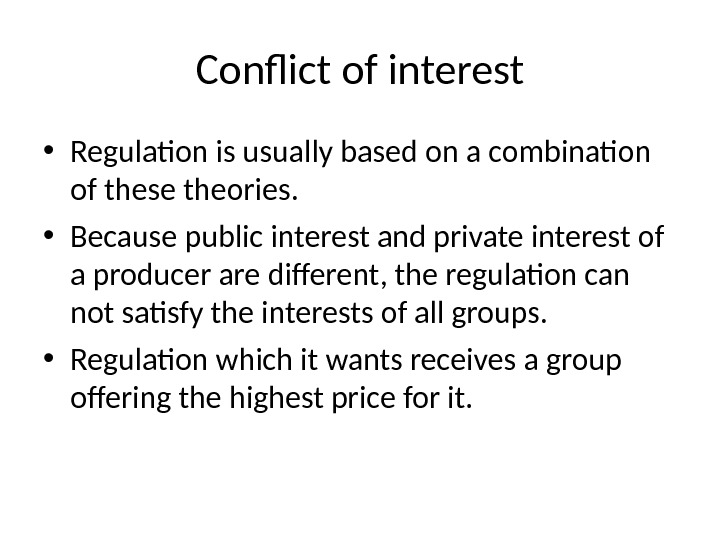
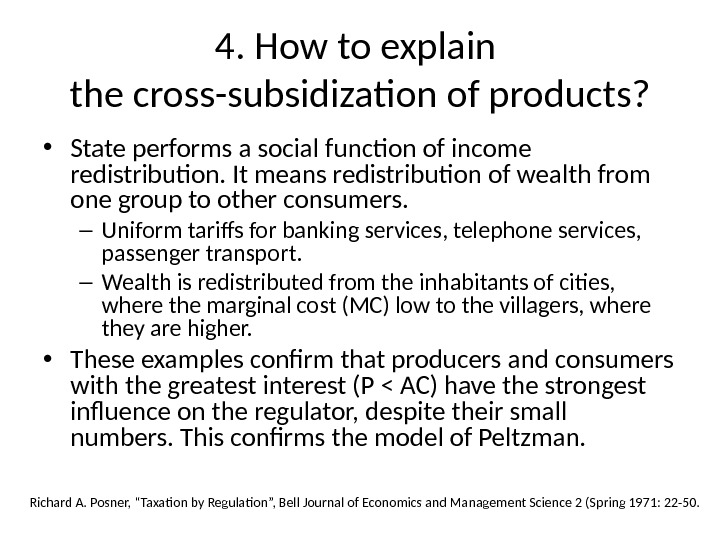
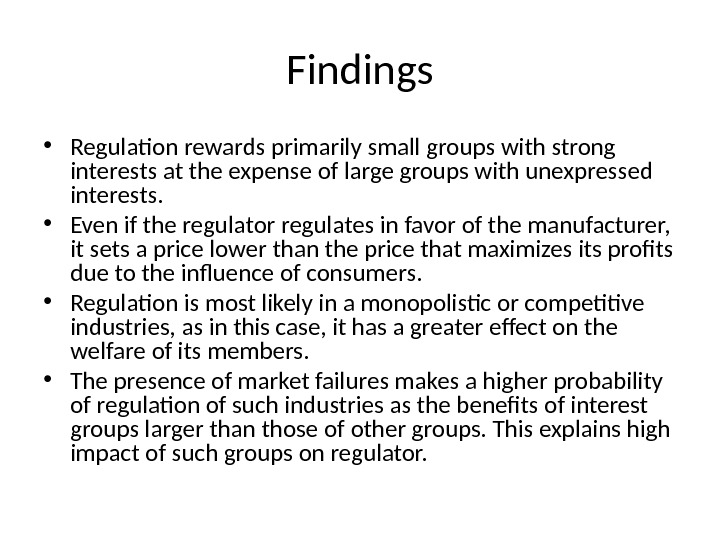
lecture_2._theory_of_government_regulation.ppt
- Размер: 455.5 Кб
- Количество слайдов: 61
Описание презентации Lecture # 2. Theory of government regulation по слайдам
 Lecture # 2. Theory of government regulation Nurlan A. Nurseiit KBTU , Spring
Lecture # 2. Theory of government regulation Nurlan A. Nurseiit KBTU , Spring
 Plan of the lecture 1. Classic schools on state regulation 2. Modern schools on state regulation a) The theory of social interest b) Capture theory c) The economic theory of regulation 3. What firms should be regulated? 4. How to explain the cross-subsidization of products?
Plan of the lecture 1. Classic schools on state regulation 2. Modern schools on state regulation a) The theory of social interest b) Capture theory c) The economic theory of regulation 3. What firms should be regulated? 4. How to explain the cross-subsidization of products?
 Introduction • The need for regulation of the economy is recognized by all economic schools. • None of them did not deny the necessity of regulation. • Different schools vary just by his vision regarding the extent, forms and methods of state regulation and the interpretation of the role of the market mechanism. • The form and extent of regulation change with the development of society.
Introduction • The need for regulation of the economy is recognized by all economic schools. • None of them did not deny the necessity of regulation. • Different schools vary just by his vision regarding the extent, forms and methods of state regulation and the interpretation of the role of the market mechanism. • The form and extent of regulation change with the development of society.
 1. Classical school on state regulation? A) Mercantilism (15 -17 century) • Stood for state intervention in the economy. • The process of primary accumulation of capital could not be done without the support of the state. • State throw laws facilitated the accumulation of gold and silver in the country, pursued a policy of development, and the protection of its own industry.
1. Classical school on state regulation? A) Mercantilism (15 -17 century) • Stood for state intervention in the economy. • The process of primary accumulation of capital could not be done without the support of the state. • State throw laws facilitated the accumulation of gold and silver in the country, pursued a policy of development, and the protection of its own industry.
 b) Physiocrats (18 th century) • The main concern of the state, from the point of view of the Physiocrats — was to protect the so-called natural laws, which are based on private ownership. • Physiocrats — did not share the views of the mercantilists and put forward the principle of laisser faire, which means the demand for freedom of entrepreneurship. • Offered the land rent as the sole source of taxation.
b) Physiocrats (18 th century) • The main concern of the state, from the point of view of the Physiocrats — was to protect the so-called natural laws, which are based on private ownership. • Physiocrats — did not share the views of the mercantilists and put forward the principle of laisser faire, which means the demand for freedom of entrepreneurship. • Offered the land rent as the sole source of taxation.
 c) Classical School (late 18 th — early 19 th century) • The main principle — «laissez faire» , ie the non-interference of the state in economic affairs. • The «invisible hand» of the market will provide the optimal allocation of resources. • The idea of public works (construction of roads, bridges, dams, mines) at expenses of the budget to ensure the job of beggars and tramps.
c) Classical School (late 18 th — early 19 th century) • The main principle — «laissez faire» , ie the non-interference of the state in economic affairs. • The «invisible hand» of the market will provide the optimal allocation of resources. • The idea of public works (construction of roads, bridges, dams, mines) at expenses of the budget to ensure the job of beggars and tramps.
 Three duties of the State according to Adam Smith • Protect society from the violence and invasion of other independent societies; • Establish a good justice in order to fencing as far as possible every member of society from the injustice and oppression of other members; • Establish and maintain certain public works and institutions, the establishment and maintenance of which may not be in the interests of individuals or small groups, and the costs of which can not be covered by individuals.
Three duties of the State according to Adam Smith • Protect society from the violence and invasion of other independent societies; • Establish a good justice in order to fencing as far as possible every member of society from the injustice and oppression of other members; • Establish and maintain certain public works and institutions, the establishment and maintenance of which may not be in the interests of individuals or small groups, and the costs of which can not be covered by individuals.
 d) The neoclassical school (late 19 th — early 20 th century) • Development of mass production, the growth of transactions increased competition have led to «market failures» associated with the presence of externalities, monopolization, the creation of public goods. • The need to strengthen support and corrective measures in the form of the creation of the market infrastructure by the state, ie system of institutions, rules of law, public goods, such as internal and external security of the development, the stability of the national currency. • Market infrastructure needed for its more effective self-regulation in the presence of imperfect competition.
d) The neoclassical school (late 19 th — early 20 th century) • Development of mass production, the growth of transactions increased competition have led to «market failures» associated with the presence of externalities, monopolization, the creation of public goods. • The need to strengthen support and corrective measures in the form of the creation of the market infrastructure by the state, ie system of institutions, rules of law, public goods, such as internal and external security of the development, the stability of the national currency. • Market infrastructure needed for its more effective self-regulation in the presence of imperfect competition.
 The neoclassical school (late 19 th — early 20 th century) • Economics — the equilibrium and self-regulating system in which a competent selfishness of its members through free competition leads to the highest welfare of society. • Therefore, direct government intervention in the market action recognized harmful. • State, without interfering directly in the operation of market forces, should create favorable conditions for effective market and business. • W. Euken — German economist (1891 -1950) argued that the state should not be allowed to regulate the economic process, but it is necessary for the formation of elements of economic order.
The neoclassical school (late 19 th — early 20 th century) • Economics — the equilibrium and self-regulating system in which a competent selfishness of its members through free competition leads to the highest welfare of society. • Therefore, direct government intervention in the market action recognized harmful. • State, without interfering directly in the operation of market forces, should create favorable conditions for effective market and business. • W. Euken — German economist (1891 -1950) argued that the state should not be allowed to regulate the economic process, but it is necessary for the formation of elements of economic order.
 The neoclassical school (late 19 th — early 20 th century) • Elements of economic order: – protection of law and order – protection of property rights – encouragement of competition – stability of national currency and its circulation – tax policy that encourages entrepreneurship.
The neoclassical school (late 19 th — early 20 th century) • Elements of economic order: – protection of law and order – protection of property rights – encouragement of competition – stability of national currency and its circulation – tax policy that encourages entrepreneurship.
 e) The Keynesian school • The first and second world wars demanded a more active role of the state in solving social and economic problems. • But the main reason was the global crisis 1930 s, which undermined the credibility of self-regulation of the market. • John Maynard Keynes (1883 -1946) theorized the need to regulate the economy , and the experience of the USSR , USA, Germany and Japan before World War II confirmed his thesis that with the help of government spending can turn the tide of economic development in the right direction. • State orders revived demand, stimulate employment , giving entrepreneurs and profits. Therefore, a famous French economist Fitoussi wrote that in the 1930 s capitalism disappeared and was replaced by a mixed economy
e) The Keynesian school • The first and second world wars demanded a more active role of the state in solving social and economic problems. • But the main reason was the global crisis 1930 s, which undermined the credibility of self-regulation of the market. • John Maynard Keynes (1883 -1946) theorized the need to regulate the economy , and the experience of the USSR , USA, Germany and Japan before World War II confirmed his thesis that with the help of government spending can turn the tide of economic development in the right direction. • State orders revived demand, stimulate employment , giving entrepreneurs and profits. Therefore, a famous French economist Fitoussi wrote that in the 1930 s capitalism disappeared and was replaced by a mixed economy
 Keynesian school • The market system is a dynamic, responsive to innovation. • However, it is not without drawbacks: – Cyclical development – Indifferent to social outcomes – The presence of market failures
Keynesian school • The market system is a dynamic, responsive to innovation. • However, it is not without drawbacks: – Cyclical development – Indifferent to social outcomes – The presence of market failures
 Keynesian school • Direction countercyclical policy: promoting growth in production during periods of recession and growth restriction during the boom through influence on investment. • Tools: public expenditures, tax rates, monetary policy based on the use of the multiplier effects. • State spending priorities: research, market infrastructure (roads, bridges, education, health care).
Keynesian school • Direction countercyclical policy: promoting growth in production during periods of recession and growth restriction during the boom through influence on investment. • Tools: public expenditures, tax rates, monetary policy based on the use of the multiplier effects. • State spending priorities: research, market infrastructure (roads, bridges, education, health care).
 Keynesian school • Keynesian model of state regulation of the economy has shown efficiency in the 30 s, during World War II and the postwar period. • Restoration, rebuilding and reconstruction of the economy in the 50 -60 s were carried out with the active role of the state. • Triumph of Keynesianism considered 50 s — early 70 s: – Rapid economic growth – Cooperation between the state and the market – Preconditions for the growth of innovation (infrastructure, personnel) – Smoothing conjunctural cycles
Keynesian school • Keynesian model of state regulation of the economy has shown efficiency in the 30 s, during World War II and the postwar period. • Restoration, rebuilding and reconstruction of the economy in the 50 -60 s were carried out with the active role of the state. • Triumph of Keynesianism considered 50 s — early 70 s: – Rapid economic growth – Cooperation between the state and the market – Preconditions for the growth of innovation (infrastructure, personnel) – Smoothing conjunctural cycles
 f) Institutional School • In the postwar years, a number of European countries (France, Germany, etc. ) and Japan were faced with the need to quickly restore the former power. • The market without government assistance was not able to do this. • Therefore were introduced the concepts of indicative planning and state dirigisme as methods of market reforms. • Representatives were French economist Fr. Perru, and Nobel Prize winners Dutch Y. Tinbergen and Swede G. Myurdal.
f) Institutional School • In the postwar years, a number of European countries (France, Germany, etc. ) and Japan were faced with the need to quickly restore the former power. • The market without government assistance was not able to do this. • Therefore were introduced the concepts of indicative planning and state dirigisme as methods of market reforms. • Representatives were French economist Fr. Perru, and Nobel Prize winners Dutch Y. Tinbergen and Swede G. Myurdal.
 Basic principles of the indicative plan • The basis of the concept — this idea of «coordinated services», ie voluntary consent of all concerned persons on the implementation of the tasks on which the success of society development depends : – Harmonization of public and private interests • The plan identifies trends and proportions optimal for sustainable economic growth, and the market ensures their achievement. – Competition of different ideas and approaches • Provide the establishing of the most best solutions. – Recommendatory nature • No administrative enforcement and responsibility of private entities for plan failing. • The plan has mandatory nature only for public sector. – Stimulatory nature • Supports by resources and incentives the changing of economy in the desired direction. – Attraction to its development of all concerned persons • Ensures its active support of different sectors of the population.
Basic principles of the indicative plan • The basis of the concept — this idea of «coordinated services», ie voluntary consent of all concerned persons on the implementation of the tasks on which the success of society development depends : – Harmonization of public and private interests • The plan identifies trends and proportions optimal for sustainable economic growth, and the market ensures their achievement. – Competition of different ideas and approaches • Provide the establishing of the most best solutions. – Recommendatory nature • No administrative enforcement and responsibility of private entities for plan failing. • The plan has mandatory nature only for public sector. – Stimulatory nature • Supports by resources and incentives the changing of economy in the desired direction. – Attraction to its development of all concerned persons • Ensures its active support of different sectors of the population.
 Key elements of the indicative plan • Prediction of the most important processes in the long, medium, or the near future; • Drafting programs , focusing economic growth to achieve the main objectives, such as growth of the national product, employment, improving the balance of payments, overcoming imbalances in the economy, infrastructure, etc. , ie strategy, and tactics of growth; • Determination the means of plan implementation : investment and subsidies from the budget system of preferences (loans, subsidies, tax exemptions, preferential tariffs for public transport and electricity); • Establishment of mechanism of plan realization, ie institutions and of economic, political and administrative measures ; • Creating plans adjustment mechanism , ie an effective feedback.
Key elements of the indicative plan • Prediction of the most important processes in the long, medium, or the near future; • Drafting programs , focusing economic growth to achieve the main objectives, such as growth of the national product, employment, improving the balance of payments, overcoming imbalances in the economy, infrastructure, etc. , ie strategy, and tactics of growth; • Determination the means of plan implementation : investment and subsidies from the budget system of preferences (loans, subsidies, tax exemptions, preferential tariffs for public transport and electricity); • Establishment of mechanism of plan realization, ie institutions and of economic, political and administrative measures ; • Creating plans adjustment mechanism , ie an effective feedback.
 Experience of indicative plan using • After the World War II, the concept of indicative planning of the economy was implemented in many countries. – France carried out the five-year plans since 1947 – Holland developed the five-year plans since 1948 , was also the prognosis for 1950 -1970 , and on 1960 -1980 was conducted “exploring economic opportunities» of the country. – Norway used the four-year plan from 1949 – Sweden used a five-year plan from 1948 – Japan used the five-year period from 1948 • National programming and indicative planning of the economy was also used in Greece, Portugal, Italy, Ireland, Belgium, England, Iceland, Spain, South Korea, Taiwan, China.
Experience of indicative plan using • After the World War II, the concept of indicative planning of the economy was implemented in many countries. – France carried out the five-year plans since 1947 – Holland developed the five-year plans since 1948 , was also the prognosis for 1950 -1970 , and on 1960 -1980 was conducted “exploring economic opportunities» of the country. – Norway used the four-year plan from 1949 – Sweden used a five-year plan from 1948 – Japan used the five-year period from 1948 • National programming and indicative planning of the economy was also used in Greece, Portugal, Italy, Ireland, Belgium, England, Iceland, Spain, South Korea, Taiwan, China.
 Government conducting • Economic recovery, its modernization and reconstruction of old and creation of new industries, accelerating the pace of economic growth and overcoming the gap with developed countries — could not be solved only by means of forecasting and planning of the economy. • This required state participation in the formation of a new structure of the economy, public administration, the process of restructuring the economy. The state was to become a conductor of the economic game. • Significant role in the justification of state dirigisme in a market economy played a market concept, which was developed by the head of the school of sociology Fr. Perru. • Used mainly in France.
Government conducting • Economic recovery, its modernization and reconstruction of old and creation of new industries, accelerating the pace of economic growth and overcoming the gap with developed countries — could not be solved only by means of forecasting and planning of the economy. • This required state participation in the formation of a new structure of the economy, public administration, the process of restructuring the economy. The state was to become a conductor of the economic game. • Significant role in the justification of state dirigisme in a market economy played a market concept, which was developed by the head of the school of sociology Fr. Perru. • Used mainly in France.
 Government conducting • Modern market does not match the ideal notions of liberal economists. • The mechanism of free competition is not fulfilling the role of regulator of equilibrium for the modern market is distorted by monopolies, oligopolies and the intervention of other institutions. • Behavior of economic agents caused by the rules of the game, were generated not by mechanism of idea exchanges, but by the balance of power of entities in the market and the degree of their monopoly power. • From this comes the need to strengthen the role of state economy, since public regulation is better than the private monopoly.
Government conducting • Modern market does not match the ideal notions of liberal economists. • The mechanism of free competition is not fulfilling the role of regulator of equilibrium for the modern market is distorted by monopolies, oligopolies and the intervention of other institutions. • Behavior of economic agents caused by the rules of the game, were generated not by mechanism of idea exchanges, but by the balance of power of entities in the market and the degree of their monopoly power. • From this comes the need to strengthen the role of state economy, since public regulation is better than the private monopoly.
 Government conducting • Creating public sector as a result of the nationalization of some industries (coal, railway, electricity, etc. ), large commercial banks and a variety of other objects. • The main task of the state economic is restructuring, concentration of production and capital to compete with foreign monopolies and ensuring of the competitiveness of the country’s products. • The principle of «privileged points of force “: – Development of industries motors — selective policy goal of the government, as they increase the scope and pace of economic expansion of the nation, modify the structure of the national economy. – Outstripping growth of heavy industry, chemistry, general engineering, oil refining. They improve other sectors (eg electronics) or prepare massive innovations in the future (eg nuclear energy).
Government conducting • Creating public sector as a result of the nationalization of some industries (coal, railway, electricity, etc. ), large commercial banks and a variety of other objects. • The main task of the state economic is restructuring, concentration of production and capital to compete with foreign monopolies and ensuring of the competitiveness of the country’s products. • The principle of «privileged points of force “: – Development of industries motors — selective policy goal of the government, as they increase the scope and pace of economic expansion of the nation, modify the structure of the national economy. – Outstripping growth of heavy industry, chemistry, general engineering, oil refining. They improve other sectors (eg electronics) or prepare massive innovations in the future (eg nuclear energy).
 Government conducting • Fr. Perru concepts used in the formation of the system of indicative planning in the French economy. • In 1946, it was issued a decree on the establishment of the General Commissariat of Planning. • In 1947 adopted a plan («Monnet») for 1947 -1950. , Extended until 1952. • In 1953 -1957 was acted second plan («Hirsch»), then the third (1957 -1961), the fourth (1962 -1965), the fifth (1966 -1970), sixth (1971 -1975) and seventh (1976 -1980).
Government conducting • Fr. Perru concepts used in the formation of the system of indicative planning in the French economy. • In 1946, it was issued a decree on the establishment of the General Commissariat of Planning. • In 1947 adopted a plan («Monnet») for 1947 -1950. , Extended until 1952. • In 1953 -1957 was acted second plan («Hirsch»), then the third (1957 -1961), the fourth (1962 -1965), the fifth (1966 -1970), sixth (1971 -1975) and seventh (1976 -1980).
 Departure from the government conducting • In the 60 s — 70 s began the retreat of the state from the policy of government conducting. • The main reasons : – Creating the European Union, which led to the rejection of protectionism. – Introducing the convertibility of national currencies – Increase of free movement of capital and labor, greatly impeded the former economic policy. – The growing influence of market conditions on the economy, which worsened predictability and foresight. – Strengthening the position of large business, which was not interested in a strong state regulation • Conjunctural policy gained a significant advantage over the policy of long term growth
Departure from the government conducting • In the 60 s — 70 s began the retreat of the state from the policy of government conducting. • The main reasons : – Creating the European Union, which led to the rejection of protectionism. – Introducing the convertibility of national currencies – Increase of free movement of capital and labor, greatly impeded the former economic policy. – The growing influence of market conditions on the economy, which worsened predictability and foresight. – Strengthening the position of large business, which was not interested in a strong state regulation • Conjunctural policy gained a significant advantage over the policy of long term growth
 g) The neoliberal school • Chronic government deficits, high inflation, the impact of the first oil crisis in the 70 s led to attacks on Keynesianism by neoliberals. • Their reasons were declared Keynesian recipes of regulation that led to the growth of government spending to support growth and social needs. • Raised again the idea of limiting government intervention in the economy of neoliberal schools: Chicago School ( L. von Mises , F. Hayek) , a social market economy (W. Röpke, L. Edhard) monetarism (M. Friedman) , supply-side economics (A. Laffer, Dzh. Gilder).
g) The neoliberal school • Chronic government deficits, high inflation, the impact of the first oil crisis in the 70 s led to attacks on Keynesianism by neoliberals. • Their reasons were declared Keynesian recipes of regulation that led to the growth of government spending to support growth and social needs. • Raised again the idea of limiting government intervention in the economy of neoliberal schools: Chicago School ( L. von Mises , F. Hayek) , a social market economy (W. Röpke, L. Edhard) monetarism (M. Friedman) , supply-side economics (A. Laffer, Dzh. Gilder).
 Chicago School • Centrally planned economy with the a regulated market and above set prices, can not long survive. • In such circumstances, there is no real market, as the prices do not reflect supply and demand, no longer serve as indicator in which direction to develop production in order to ensure the economic balance. • This means that the regulated economy of socialism «becomes in fact the kingdom of arbitrariness of plan compilers, ie the planned chaos.
Chicago School • Centrally planned economy with the a regulated market and above set prices, can not long survive. • In such circumstances, there is no real market, as the prices do not reflect supply and demand, no longer serve as indicator in which direction to develop production in order to ensure the economic balance. • This means that the regulated economy of socialism «becomes in fact the kingdom of arbitrariness of plan compilers, ie the planned chaos.
 Chicago School • Strengthening the role of the state leads to strengthen the role of the bureaucracy, which has a negative impact on the economy: – Increasing corruption, – Reducing the efficiency of production; – Emergence of the type of person for whom the «follow the familiar and outdated and» strangulation «of innovators is the main of all virtues. “ • State intervention in the economy is bad for society, generating instability and disrupting the natural course of development. • The only sound economic policy of industrial society can be liberalism, ie providing complete freedom to producers, acting on the market.
Chicago School • Strengthening the role of the state leads to strengthen the role of the bureaucracy, which has a negative impact on the economy: – Increasing corruption, – Reducing the efficiency of production; – Emergence of the type of person for whom the «follow the familiar and outdated and» strangulation «of innovators is the main of all virtues. “ • State intervention in the economy is bad for society, generating instability and disrupting the natural course of development. • The only sound economic policy of industrial society can be liberalism, ie providing complete freedom to producers, acting on the market.
 School of social market economy • Principle: «competition everywhere — where possible, the state — where necessary. ” • Role of the state: – Creating favorable conditions for a functioning market economy. – Elaboration of procedures and rules of the game and their enforcement as suggested by neoclassical economists: • German Chancellor Ludwig Erhard was convinced , that the task of the state is not included direct interventions, but it must carry out and be responsible for the economic policy. – Image: Referee on the football field, which itself does not play, but vigilantly enforces rules. – Spheres: regulation of monopolies, social and stabilization policy.
School of social market economy • Principle: «competition everywhere — where possible, the state — where necessary. ” • Role of the state: – Creating favorable conditions for a functioning market economy. – Elaboration of procedures and rules of the game and their enforcement as suggested by neoclassical economists: • German Chancellor Ludwig Erhard was convinced , that the task of the state is not included direct interventions, but it must carry out and be responsible for the economic policy. – Image: Referee on the football field, which itself does not play, but vigilantly enforces rules. – Spheres: regulation of monopolies, social and stabilization policy.
 Monetarism • There are two ways of coordinating economic life — centralized management conjugate with coercion of people and voluntary cooperation of individuals provided by the market. • Regulatory functions are recognized for the market, because State bad manager. • So the only area of state intervention — the circulation of money to ensure its stability.
Monetarism • There are two ways of coordinating economic life — centralized management conjugate with coercion of people and voluntary cooperation of individuals provided by the market. • Regulatory functions are recognized for the market, because State bad manager. • So the only area of state intervention — the circulation of money to ensure its stability.
 Monetarism • In conditions of world hyperinflation 70 s. in the XX century. Friedman offered to the Government the program of its overcoming: – Refusal from the cyclic monetary policy. Their growth of money has to be no more than 3 -5% per year. – Setting a high bank interest rates. – Minimization of wage growth, which requires to keep unemployment at a certain level. – Reduction government expenditures, which would reduce the budget deficit.
Monetarism • In conditions of world hyperinflation 70 s. in the XX century. Friedman offered to the Government the program of its overcoming: – Refusal from the cyclic monetary policy. Their growth of money has to be no more than 3 -5% per year. – Setting a high bank interest rates. – Minimization of wage growth, which requires to keep unemployment at a certain level. – Reduction government expenditures, which would reduce the budget deficit.
 Practical application of monetarism • Implementation of monetary rules of M. Friedman to monetary growth, reduced the budget deficit, limited the growth of wages, increased interest rates and led to the suppression of hyperinflation 70 s — early 80 s. • However, interest rates in the early 1980 s. reached very high level that: – hindered growth in business activity. – caused dissatisfaction small and medium business
Practical application of monetarism • Implementation of monetary rules of M. Friedman to monetary growth, reduced the budget deficit, limited the growth of wages, increased interest rates and led to the suppression of hyperinflation 70 s — early 80 s. • However, interest rates in the early 1980 s. reached very high level that: – hindered growth in business activity. – caused dissatisfaction small and medium business
 The supply-side economics theory • It was the Response to the stagnation of production caused by the crisis 70 s. • Reduced tax rates for the richest segments of the population — a major incentive for growth in supply: – Income tax rate in the United States under Ronald Reagan was reduced from 70 to 50% and then to 38% – Reduced taxation of gifts, real estate, savings and investments. – Tax scale has become flatter. – Reduced depreciation periods for investment incentives.
The supply-side economics theory • It was the Response to the stagnation of production caused by the crisis 70 s. • Reduced tax rates for the richest segments of the population — a major incentive for growth in supply: – Income tax rate in the United States under Ronald Reagan was reduced from 70 to 50% and then to 38% – Reduced taxation of gifts, real estate, savings and investments. – Tax scale has become flatter. – Reduced depreciation periods for investment incentives.
 The supply-side economics theory • With the new tax policy, as well as an expansive monetary policy succeeded in creating a favorable business environment. • The American economy in the 80 s. overcome stagnation and has entered a period of economic growth.
The supply-side economics theory • With the new tax policy, as well as an expansive monetary policy succeeded in creating a favorable business environment. • The American economy in the 80 s. overcome stagnation and has entered a period of economic growth.
 Nowadays • The crisis of neoliberal theories. • They failed. Following their recommendations led to the global crisis. • Under these conditions, even countries with strong neo-liberal tendencies intensified state intervention in the economy.
Nowadays • The crisis of neoliberal theories. • They failed. Following their recommendations led to the global crisis. • Under these conditions, even countries with strong neo-liberal tendencies intensified state intervention in the economy.
 2. Modern theories of state regulation • Theory of regulation — is the application of the general theory of public choice. • It explains the objectives of the government, the election which it makes and the consequences of those choices. • State exist for two main reasons: – To install the property rights and the rules by which redistribute income and wealth. – Providing non-market mechanism of the placement of limited resources when the market is not efficient. Such situations are called market failures.
2. Modern theories of state regulation • Theory of regulation — is the application of the general theory of public choice. • It explains the objectives of the government, the election which it makes and the consequences of those choices. • State exist for two main reasons: – To install the property rights and the rules by which redistribute income and wealth. – Providing non-market mechanism of the placement of limited resources when the market is not efficient. Such situations are called market failures.
 Three theory of regulation a) The theory of social interest – Stiglyar J. , 1971; L. Dzhoskov, 1981 b) Capture theory – Jordan, 1972 c) The economic theory of regulation – J. Stiglyar, 1971; Peltzman, 1976; Becker,
Three theory of regulation a) The theory of social interest – Stiglyar J. , 1971; L. Dzhoskov, 1981 b) Capture theory – Jordan, 1972 c) The economic theory of regulation – J. Stiglyar, 1971; Peltzman, 1976; Becker,
 a) The theory of social interest • The reasons for regulation – Market failures, the inequitable distribution of income: – Regulation of monopolies and oligopolies – Provision of public goods – Externalities – Use of shared resources – Redistribution of income • The purpose of regulation – Ensuring the functioning of the economy in the public interests. • Regulatory Services – Designed to maximize consumer and producer surplus. George J. Stigler “The Theory of Economic Regulation”, Bell Journal of Economics and Management Science 2 (Spring 1971): 3 -21; Paul L. Joskow, Roger G. Noll “Regulation in Theory and Practice: An Overview”, in Gary Fromm, ed. , Studies in Public Regulation (Cambridge: MIT Press, 1981)
a) The theory of social interest • The reasons for regulation – Market failures, the inequitable distribution of income: – Regulation of monopolies and oligopolies – Provision of public goods – Externalities – Use of shared resources – Redistribution of income • The purpose of regulation – Ensuring the functioning of the economy in the public interests. • Regulatory Services – Designed to maximize consumer and producer surplus. George J. Stigler “The Theory of Economic Regulation”, Bell Journal of Economics and Management Science 2 (Spring 1971): 3 -21; Paul L. Joskow, Roger G. Noll “Regulation in Theory and Practice: An Overview”, in Gary Fromm, ed. , Studies in Public Regulation (Cambridge: MIT Press, 1981)
 Regulation of monopolies and oligopolies • Monopolies and oligopolies and their aspiration to reception economic rents prevents efficient allocation of resources and redistributes consumer surplus in favor of the manufacturer. • Example, natural monopolies – Production efficiency (in the industry is efficient only one firm as AC decreases for all Q) – The inefficiency of resource allocation (no competition leads to the fact that P > MC)
Regulation of monopolies and oligopolies • Monopolies and oligopolies and their aspiration to reception economic rents prevents efficient allocation of resources and redistributes consumer surplus in favor of the manufacturer. • Example, natural monopolies – Production efficiency (in the industry is efficient only one firm as AC decreases for all Q) – The inefficiency of resource allocation (no competition leads to the fact that P > MC)
 Provision of public goods • Public goods — are goods that are consumed by each person and from consumption of which nobody can be excluded. • Examples: national defense, law, waste disposal, waste removal services. • Market economy underperforms these products, since it is impossible to exclude not payers from their consumption — free-rider problem.
Provision of public goods • Public goods — are goods that are consumed by each person and from consumption of which nobody can be excluded. • Examples: national defense, law, waste disposal, waste removal services. • Market economy underperforms these products, since it is impossible to exclude not payers from their consumption — free-rider problem.
 External effects • External costs and benefits there are results of the relationship between two parties who are caught and consumed by a third party. • Chemical Plant, poured waste into the river, destroying fish, imposes external costs on the fishing company. • The bank, which builds beautiful office creates external benefits for all residents. • External costs and benefits cause that the market fails to allocate resources efficiently.
External effects • External costs and benefits there are results of the relationship between two parties who are caught and consumed by a third party. • Chemical Plant, poured waste into the river, destroying fish, imposes external costs on the fishing company. • The bank, which builds beautiful office creates external benefits for all residents. • External costs and benefits cause that the market fails to allocate resources efficiently.
 An example of external effect • Jerry buys fish sandwich: – If the market is competitive, then P = AC – Jerry benefits from sandwich is V. – Social benefits = (V-P)> 0 • However, he goes on a crowded bus: – Willie goes next. His feel sick from the smell of fish. – He gets damage in the amount of W If W> V, then the social benefit = (VP)-W <0 • Competitive market if the external effect does not always lead to the common good
An example of external effect • Jerry buys fish sandwich: – If the market is competitive, then P = AC – Jerry benefits from sandwich is V. – Social benefits = (V-P)> 0 • However, he goes on a crowded bus: – Willie goes next. His feel sick from the smell of fish. – He gets damage in the amount of W If W> V, then the social benefit = (VP)-W <0 • Competitive market if the external effect does not always lead to the common good
 The use of common resources • Some resources which do not belong to somebody and used by all. • Examples: a fish in the ocean, lake and river, oil on the high seas. • Market economy overuses these resources, since nobody is interested in their conservation — community problem.
The use of common resources • Some resources which do not belong to somebody and used by all. • Examples: a fish in the ocean, lake and river, oil on the high seas. • Market economy overuses these resources, since nobody is interested in their conservation — community problem.
 Income redistribution • The unequal distribution of income and wealth is inherent to the market economy. • To remedy the situation are introduced progressive income taxes for payment of public goods and for income redistribution.
Income redistribution • The unequal distribution of income and wealth is inherent to the market economy. • To remedy the situation are introduced progressive income taxes for payment of public goods and for income redistribution.
 The theory of social interest • In the case of a natural monopoly State seeks efficiency: – of production by allowing only one firm. – Of resource allocation — with the help of price regulation. • In the case of external effects it achieves optimal social distribution by: – setting taxes on activity of the subjects, causing negative externalities – providing subsidies to subjects with positive externalities
The theory of social interest • In the case of a natural monopoly State seeks efficiency: – of production by allowing only one firm. – Of resource allocation — with the help of price regulation. • In the case of external effects it achieves optimal social distribution by: – setting taxes on activity of the subjects, causing negative externalities – providing subsidies to subjects with positive externalities
 Criticism of theory of social interest • Incompleteness of theory – There is no mechanism for how regulation leads to the desired results? – There is no evidence that the controller always operates in the public interest. • Not explain many facts – Extent of regulation is not related to the magnitude of market failures. – Profit of regulated firms grew in the 1960 s, when prices were higher costs and regulation hindered entry of new firms: – Examples: taxi markets, freight, securities in the US. • Some firms lobbying regulation by themselves – Allows to protect from the competition – Provides consistently high profit – Examples: Railways in the 1880 s, long distance telephony • Does not explain the facts, why regulatory agencies sometimes act in the interests of the regulated entities?
Criticism of theory of social interest • Incompleteness of theory – There is no mechanism for how regulation leads to the desired results? – There is no evidence that the controller always operates in the public interest. • Not explain many facts – Extent of regulation is not related to the magnitude of market failures. – Profit of regulated firms grew in the 1960 s, when prices were higher costs and regulation hindered entry of new firms: – Examples: taxi markets, freight, securities in the US. • Some firms lobbying regulation by themselves – Allows to protect from the competition – Provides consistently high profit – Examples: Railways in the 1880 s, long distance telephony • Does not explain the facts, why regulatory agencies sometimes act in the interests of the regulated entities?
 b) Capture Theory • Essence. Regulatory agencies fall under the control of business • The purpose of regulating of state is transformed into the maximization of economic profit of producers. • Features. Regulation becomes one-sided bias in favor of the producers. William A. Jordan, “Producer Protection, Prior Market Structure and the Effects of Government Regulation”, Journal of Law and Economics (15 April 1972), 151 —
b) Capture Theory • Essence. Regulatory agencies fall under the control of business • The purpose of regulating of state is transformed into the maximization of economic profit of producers. • Features. Regulation becomes one-sided bias in favor of the producers. William A. Jordan, “Producer Protection, Prior Market Structure and the Effects of Government Regulation”, Journal of Law and Economics (15 April 1972), 151 —
 U. S. Peanut program, • Launched in the United States since 1949. – Limits cashew farmers (23 thousand) – Limits import nuts. – Limits minimum prices — above the world by 50%. • Results of the program: – In 1982 -1987 was a transfer of resources from consumers to firms in $ 255 million (Price 1987). – Loss of «dead weight» of $ 34 million – Each farmer received a payment of $ 11. 1 thousand. – Each buyer spent — $1. 23 Firms lobbied the program, as each of them has received $ 11 thd. Consumers did not fight against it, as $1. 23 for each of them is too small sum.
U. S. Peanut program, • Launched in the United States since 1949. – Limits cashew farmers (23 thousand) – Limits import nuts. – Limits minimum prices — above the world by 50%. • Results of the program: – In 1982 -1987 was a transfer of resources from consumers to firms in $ 255 million (Price 1987). – Loss of «dead weight» of $ 34 million – Each farmer received a payment of $ 11. 1 thousand. – Each buyer spent — $1. 23 Firms lobbied the program, as each of them has received $ 11 thd. Consumers did not fight against it, as $1. 23 for each of them is too small sum.
 c) The theory of economic regulation • Factors of influence: – Demand voters and firms – Proposal politicians and officials • Equilibrium is achieved when the balance of interests of both sides of the market is achieved.
c) The theory of economic regulation • Factors of influence: – Demand voters and firms – Proposal politicians and officials • Equilibrium is achieved when the balance of interests of both sides of the market is achieved.
 Demand for regulation • It is created by voters and businesses. – Consumers are willing to lower prices. – Firm (insiders) wish high and stable profits. – Firms (outsiders) wish liberalized market. • The greater the potential benefit from the regulation, the more — the demand for it from consumers. • Small but organized groups are more effective than large but unorganized groups. • Demand depends on 4 main factors: – Consumer surplus per buyer – Number of buyers – Producer surplus per firm – Number of firms
Demand for regulation • It is created by voters and businesses. – Consumers are willing to lower prices. – Firm (insiders) wish high and stable profits. – Firms (outsiders) wish liberalized market. • The greater the potential benefit from the regulation, the more — the demand for it from consumers. • Small but organized groups are more effective than large but unorganized groups. • Demand depends on 4 main factors: – Consumer surplus per buyer – Number of buyers – Producer surplus per firm – Number of firms
 Demand on regulation • Voters and businesses to express their preferences regarding the issue of public goods and services by voting, participating in companies and lobbying government officials. • They also pay taxes, which are the resources to pay for public goods and services.
Demand on regulation • Voters and businesses to express their preferences regarding the issue of public goods and services by voting, participating in companies and lobbying government officials. • They also pay taxes, which are the resources to pay for public goods and services.
 Antitrust agency • Three types of workers – Policies (it tends to move to a more prestigious office) – Careerist (wants agency existed and grew) – Professional (for the sake of moving the new tasks) • Their goals are different in the regulatory process: – Policies for meeting the interests of different groups. – Careerist for a simple set of steps to avoid problems. – Professional for a complex set of measures supported by theory.
Antitrust agency • Three types of workers – Policies (it tends to move to a more prestigious office) – Careerist (wants agency existed and grew) – Professional (for the sake of moving the new tasks) • Their goals are different in the regulatory process: – Policies for meeting the interests of different groups. – Careerist for a simple set of steps to avoid problems. – Professional for a complex set of measures supported by theory.
 Supply of regulation • It is created by politicians and bureaucrats (careerists and professionals) – Policies offer a policy that reflects the aspirations of the electorate. – Officials support the policy that maximizes their budgets. • Offer depends on 3 main factors: – Consumer surplus per buyer – Producer surplus in per firm – Number of interested people in it.
Supply of regulation • It is created by politicians and bureaucrats (careerists and professionals) – Policies offer a policy that reflects the aspirations of the electorate. – Officials support the policy that maximizes their budgets. • Offer depends on 3 main factors: – Consumer surplus per buyer – Producer surplus in per firm – Number of interested people in it.
 Market equilibrium • The purpose of politicians — to be elected and remain in office. • Voices for politicians — is that the profits for firms. They have a policy that gives the required number of votes to be re-elected. • Officials produce public goods and services in the form of laws and regulations.
Market equilibrium • The purpose of politicians — to be elected and remain in office. • Voices for politicians — is that the profits for firms. They have a policy that gives the required number of votes to be re-elected. • Officials produce public goods and services in the form of laws and regulations.
 Market equilibrium • This is the result of simultaneous choice of voters, politicians and government officials. • Situation in which the election of all three groups are the same and no one group can improve their situation by making different choices. • No interest group sees need to use additional resources to requirements changes. • And no group of politicians or officials propose new forms of regulation. • Equilibrium can pursue both public and private interest. What firms should be regulated?
Market equilibrium • This is the result of simultaneous choice of voters, politicians and government officials. • Situation in which the election of all three groups are the same and no one group can improve their situation by making different choices. • No interest group sees need to use additional resources to requirements changes. • And no group of politicians or officials propose new forms of regulation. • Equilibrium can pursue both public and private interest. What firms should be regulated?
 3. What firms should be regulated? Peltzman’s model , РМ )Р( Copyright © 2004 South-Western Price 0 Profit π PM 2 M 1 P M P K P* π (P) — monopoly profits depend on price changes. M (P, π) — Political support depends negatively on the price and positively on profit in the industry. Political support is growing in the N-W corner: M 3> M 2> M 1. M 3 If the price is of P* in the absence of regulation, the regulation is not necessary. Firms will benefit only in the case of regulation of a competitive industry, and consumers — monopolistic industry. Sam Peltzman, “Toward a More General Theory of Regulation”,
3. What firms should be regulated? Peltzman’s model , РМ )Р( Copyright © 2004 South-Western Price 0 Profit π PM 2 M 1 P M P K P* π (P) — monopoly profits depend on price changes. M (P, π) — Political support depends negatively on the price and positively on profit in the industry. Political support is growing in the N-W corner: M 3> M 2> M 1. M 3 If the price is of P* in the absence of regulation, the regulation is not necessary. Firms will benefit only in the case of regulation of a competitive industry, and consumers — monopolistic industry. Sam Peltzman, “Toward a More General Theory of Regulation”,
 Becker model • Shows different groups compete for influence over the regulator. Suppose there are two groups. – The more influence on the control group, the greater its wealth under the current influence of the other group. – Less the effect of one group on the controller, the more influence the other. – Influence of the first group P 1 , and the second group — P 2. The influence of each group depends on a number of its members and the resources each can allocate to influence on the regulator. – Transfer of wealth (T) to the first group from the second depends on its impact on the controller and influence of the second group: T 1 = I (P 1 , P 2 ). – Then losing of second group consisted of T 2 = T 1 * x, where x — losses in the process of regulation itself. • The optimal level of influence of the first group of P 1 under the influence of another group in the amount of P 2 will ψ 1 (P 2 ). • The optimal level of influence of the second group P 2 under the influence of another group in the amount of P 1 will ψ 2 (P 1 ). Gary S. Becker, “A Theory of Competition Among Pressure Groups for Political Influence”, Quarterly Journal of Economics 98 (August 1983): p. 371 -400.
Becker model • Shows different groups compete for influence over the regulator. Suppose there are two groups. – The more influence on the control group, the greater its wealth under the current influence of the other group. – Less the effect of one group on the controller, the more influence the other. – Influence of the first group P 1 , and the second group — P 2. The influence of each group depends on a number of its members and the resources each can allocate to influence on the regulator. – Transfer of wealth (T) to the first group from the second depends on its impact on the controller and influence of the second group: T 1 = I (P 1 , P 2 ). – Then losing of second group consisted of T 2 = T 1 * x, where x — losses in the process of regulation itself. • The optimal level of influence of the first group of P 1 under the influence of another group in the amount of P 2 will ψ 1 (P 2 ). • The optimal level of influence of the second group P 2 under the influence of another group in the amount of P 1 will ψ 2 (P 1 ). Gary S. Becker, “A Theory of Competition Among Pressure Groups for Political Influence”, Quarterly Journal of Economics 98 (August 1983): p. 371 -400.
 , РМ )Р( Copyright © 2004 South-Western 0 P 2 — Influence of the 2 group P 1 — Influence of the 1 group p 1 0 Gary S. Becker, “A Theory of Competition Among Pressure Groups for Political Influence”, 1983 Р 2 1 Р 1 0 2 Р 1 2 p 2 0 p 1 *p 2 ’’ p 2 * 2 рˆ 2 рˆ 1 рˆ Focuses on the role of interest groups and suggests that they compete with each other for influence on the regulator. The greater influence of a group, the greater the growth of its wealth. The growing influence of one group decreases the influence of the other. A political equilibrium Becker model
, РМ )Р( Copyright © 2004 South-Western 0 P 2 — Influence of the 2 group P 1 — Influence of the 1 group p 1 0 Gary S. Becker, “A Theory of Competition Among Pressure Groups for Political Influence”, 1983 Р 2 1 Р 1 0 2 Р 1 2 p 2 0 p 1 *p 2 ’’ p 2 * 2 рˆ 2 рˆ 1 рˆ Focuses on the role of interest groups and suggests that they compete with each other for influence on the regulator. The greater influence of a group, the greater the growth of its wealth. The growing influence of one group decreases the influence of the other. A political equilibrium Becker model
 Predictions of the model of Becker • Optimal effect of each group depends not only on the efforts of the group, but its competitors. It is relative issue. • Ceteris paribus, that group loses, which has more conditions for a ticketless travel. • Equilibrium is not a Pareto efficient. Both groups can use less resources, and achieve the same effect as when using more resources. • An industry that suffers from market failures more likely subjected to regulation, than a more competitive industry.
Predictions of the model of Becker • Optimal effect of each group depends not only on the efforts of the group, but its competitors. It is relative issue. • Ceteris paribus, that group loses, which has more conditions for a ticketless travel. • Equilibrium is not a Pareto efficient. Both groups can use less resources, and achieve the same effect as when using more resources. • An industry that suffers from market failures more likely subjected to regulation, than a more competitive industry.
 Why regulation will undergo less competitive industry? • Suppose A natural monopoly industry, and B — competitive industry. • Losses to society from the regulation of the industry B will be in higher than the industry A. • Hence the industry A will be regulated more than industry B. • Thus, this model confirms the conclusions of the model of social interest.
Why regulation will undergo less competitive industry? • Suppose A natural monopoly industry, and B — competitive industry. • Losses to society from the regulation of the industry B will be in higher than the industry A. • Hence the industry A will be regulated more than industry B. • Thus, this model confirms the conclusions of the model of social interest.
 Conflict of interest • Regulation is usually based on a combination of these theories. • Because public interest and private interest of a producer are different, the regulation can not satisfy the interests of all groups. • Regulation which it wants receives a group offering the highest price for it.
Conflict of interest • Regulation is usually based on a combination of these theories. • Because public interest and private interest of a producer are different, the regulation can not satisfy the interests of all groups. • Regulation which it wants receives a group offering the highest price for it.
 4. How to explain the cross-subsidization of products? • State performs a social function of income redistribution. It means redistribution of wealth from one group to other consumers. – Uniform tariffs for banking services, telephone services, passenger transport. – Wealth is redistributed from the inhabitants of cities, where the marginal cost (MC) low to the villagers, where they are higher. • These examples confirm that producers and consumers with the greatest interest (P < AC) have the strongest influence on the regulator, despite their small numbers. This confirms the model of Peltzman. Richard A. Posner, “Taxation by Regulation”, Bell Journal of Economics and Management Science 2 (Spring 1971: 22 -50.
4. How to explain the cross-subsidization of products? • State performs a social function of income redistribution. It means redistribution of wealth from one group to other consumers. – Uniform tariffs for banking services, telephone services, passenger transport. – Wealth is redistributed from the inhabitants of cities, where the marginal cost (MC) low to the villagers, where they are higher. • These examples confirm that producers and consumers with the greatest interest (P < AC) have the strongest influence on the regulator, despite their small numbers. This confirms the model of Peltzman. Richard A. Posner, “Taxation by Regulation”, Bell Journal of Economics and Management Science 2 (Spring 1971: 22 -50.
 Findings • Regulation rewards primarily small groups with strong interests at the expense of large groups with unexpressed interests. • Even if the regulator regulates in favor of the manufacturer, it sets a price lower than the price that maximizes its profits due to the influence of consumers. • Regulation is most likely in a monopolistic or competitive industries, as in this case, it has a greater effect on the welfare of its members. • The presence of market failures makes a higher probability of regulation of such industries as the benefits of interest groups larger than those of other groups. This explains high impact of such groups on regulator.
Findings • Regulation rewards primarily small groups with strong interests at the expense of large groups with unexpressed interests. • Even if the regulator regulates in favor of the manufacturer, it sets a price lower than the price that maximizes its profits due to the influence of consumers. • Regulation is most likely in a monopolistic or competitive industries, as in this case, it has a greater effect on the welfare of its members. • The presence of market failures makes a higher probability of regulation of such industries as the benefits of interest groups larger than those of other groups. This explains high impact of such groups on regulator.

